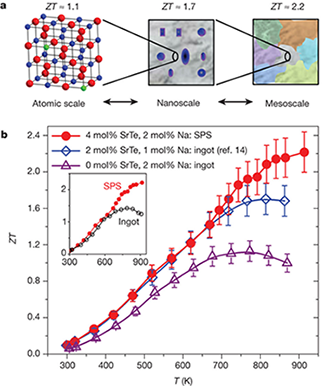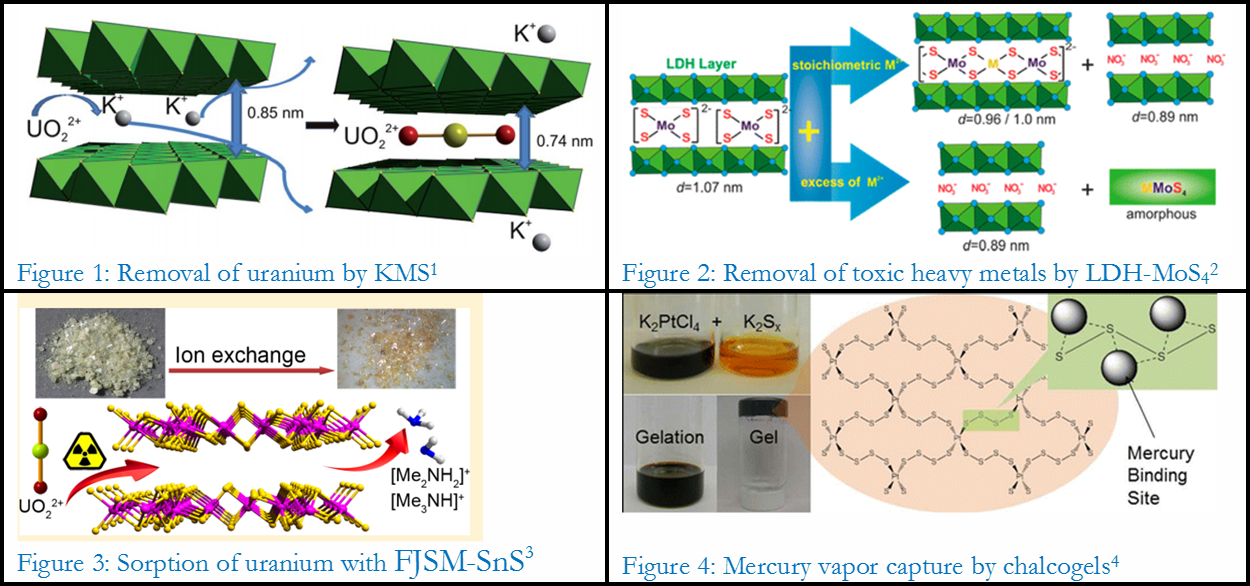CAMEE Research Areas
CAMEE focuses on a variety of research areas in the fields of clean energy production, conservation, and environmental remediation.
Thermoelectrics
More than two-thirds of global energy is lost as wasted heat. Thermoelectric devices are capable of converting heat into usable power, which makes them attractive candidates for a variety of applications including waste heat recovery and clean power generation.
 |
| Figure: (a) All-length scale hierarchical architectures scatter phonons across a broad range of wavelengths, which minimizes thermal conductivity and enhances thermoelectric performance, as shown in (b). |
Thermoelectric modules require materials that can convert an applied thermal gradient into an electrical potential. An efficient thermoelectric material must have a large Seebeck coefficient, while also exhibiting high electrical conductivity and low thermal conductivity. The thrust of CAMEE’s research in thermoelectrics relates to simultaneously optimizing the electronic and thermal properties of thermoelectric materials, which can be quite challenging due to the complex relationship between these parameters.
In the last decade, new design concepts have stimulated rapid growth in thermoelectric research, which has led to a new series of materials with exceptional thermoelectric performance. For example, CAMEE researchers have introduced the concept of "all-scale hierarchical architectures," which combines point defects, nanostructuring, and mesoscale structuring into a single material. This new family of materials can exhibit ultra-low thermal conductivity while also maintaining or improving electronic transport properties.
CAMEE is working to develop novel synthetic and processing methods that can be used to further optimize the growing library of thermoelectric materials, while also seeking to discover novel metal chalcogenide compounds that can be used in these applications.
Perovskite Solar Cells
Perovskite solar cells hold an advantage over traditional silicon solar cells in the simplicity of their processing. In recent years, the conversion efficiency of perovskite solar cells has increased dramatically. Their efficiency now surpasses by a large margin both organic photovoltaics and quantum dot photovoltaics, and rivals established thin film photovoltaic technologies based on amorphous silicon, CdTe, CuIn1−xGaxSe2, and GaAs.
 |
| Figure: Feasible solution process method to prepare low-cost high-performance solar cells. |
CAMEE leads the pioneer research in materials design, mechanistic understanding, and performance metrics to fabricate perovskite solar cells from non-toxic, earth-abundant, environment-friendly, and low-cost materials. With simple solution processing, CAMEE is offering the prospect of efficient, low-cost, and large-scale solar electricity production.
CAMEE’s research on perovskite solar cells combines theoretical understanding and advanced experimental characterization of novel materials. In addition to exploring charge transport, electrode microstructure, interface and surface chemistry of photovoltaic devices, CAMEE also seeks to enrich the fundamental understanding of photon capture, exciton creation and decay, exciton dissociation/quenching, defect formations, doping, and order and disorder in crystal structure of material properties. Acquiring a better understanding these phenomena directly informs CAMEE’s research as it designs new materials and continues to push the limits of solar cell production.
Environmental Remediation
The treatment of various types of aqueous waste, such as industrial and nuclear waste discharges, pose a serious threat to humans and other species throughout the world. At CAMEE, researchers are developing discovery of novel, efficient, cheap, sustainable materials that can be used in water treatment for capturing radioactive materials and toxic heavy metals. Such materials are not only important for the health of the planet, but they also have implications for energy production.
 |
CAMEE researchers have developed a new class of porous, amorphous gels, known as “chalcogels,” that are highly efficient at capturing and separating mercury vapor and radioactive iodine. These materials display exceptional selectivity and rapid sorption kinetics for soft or relatively soft metal ions as a result of their soft basic frameworks.
CAMEE is also developing materials to extract uranium from nuclear waste and from seawater, where it is highly present (4 × 1012 kg at ∼3 ppb) but highly dissolved and challenging to harvest. If successful in harvesting uranium from these sites, CAMEE’s materials could potentially recycle it as a fuel for nuclear power.


